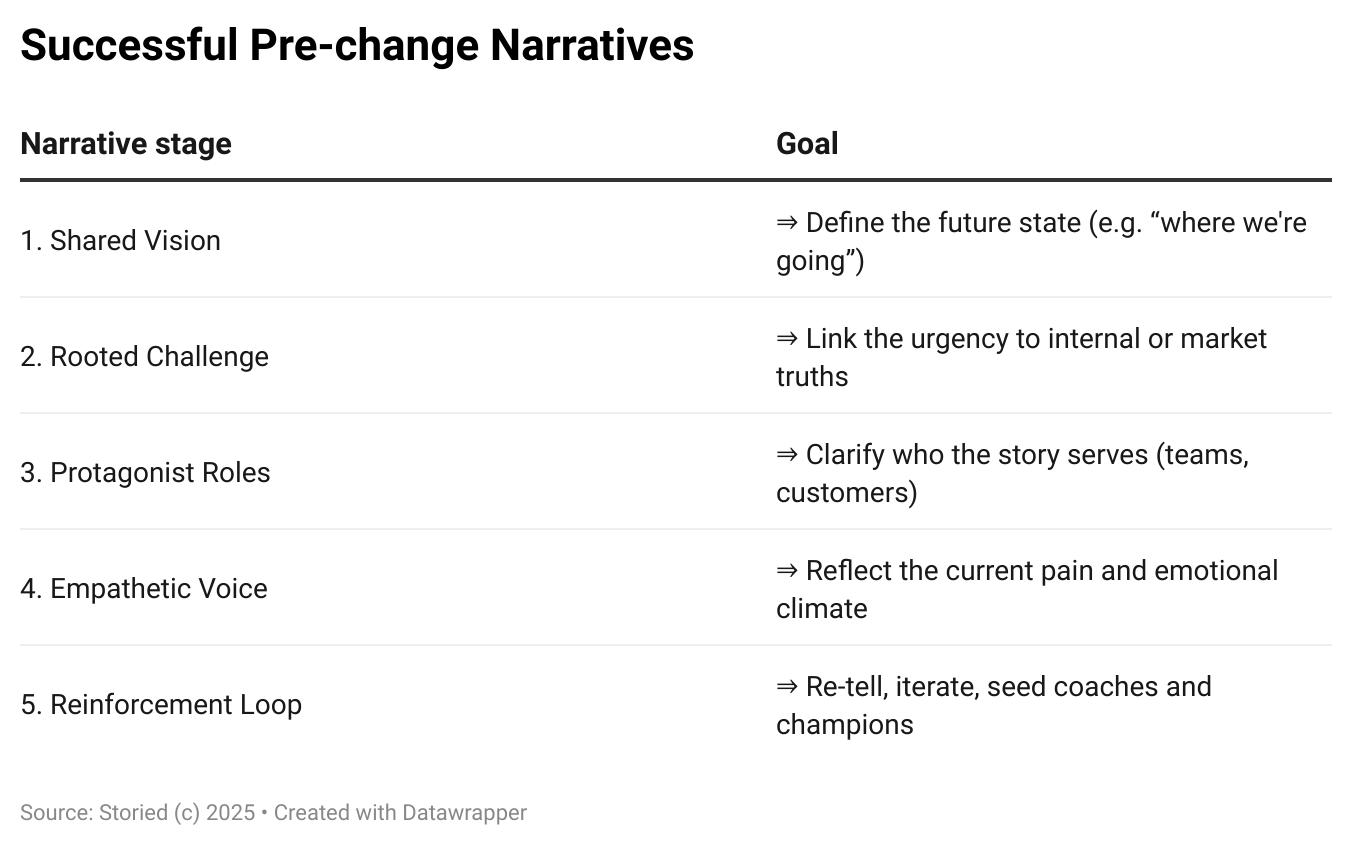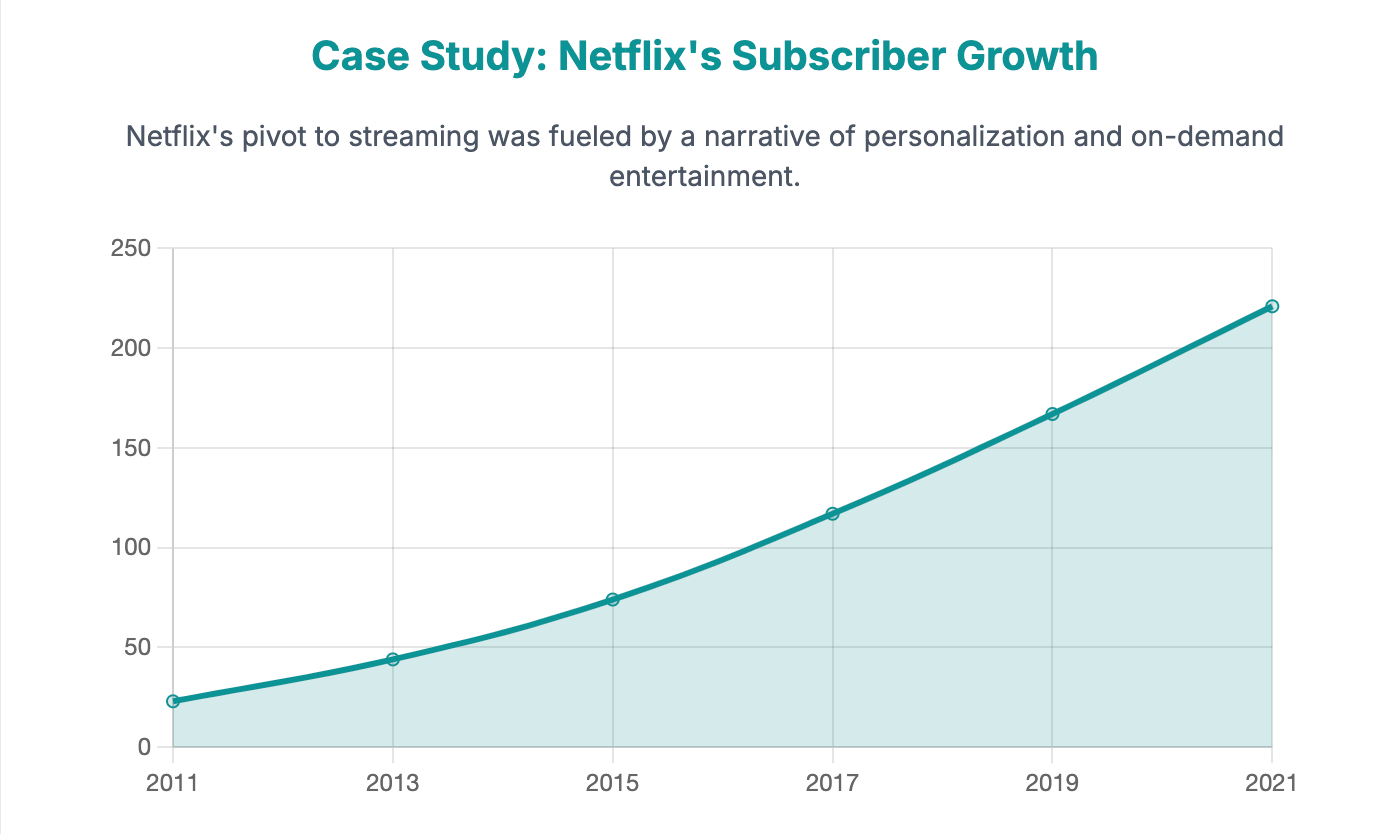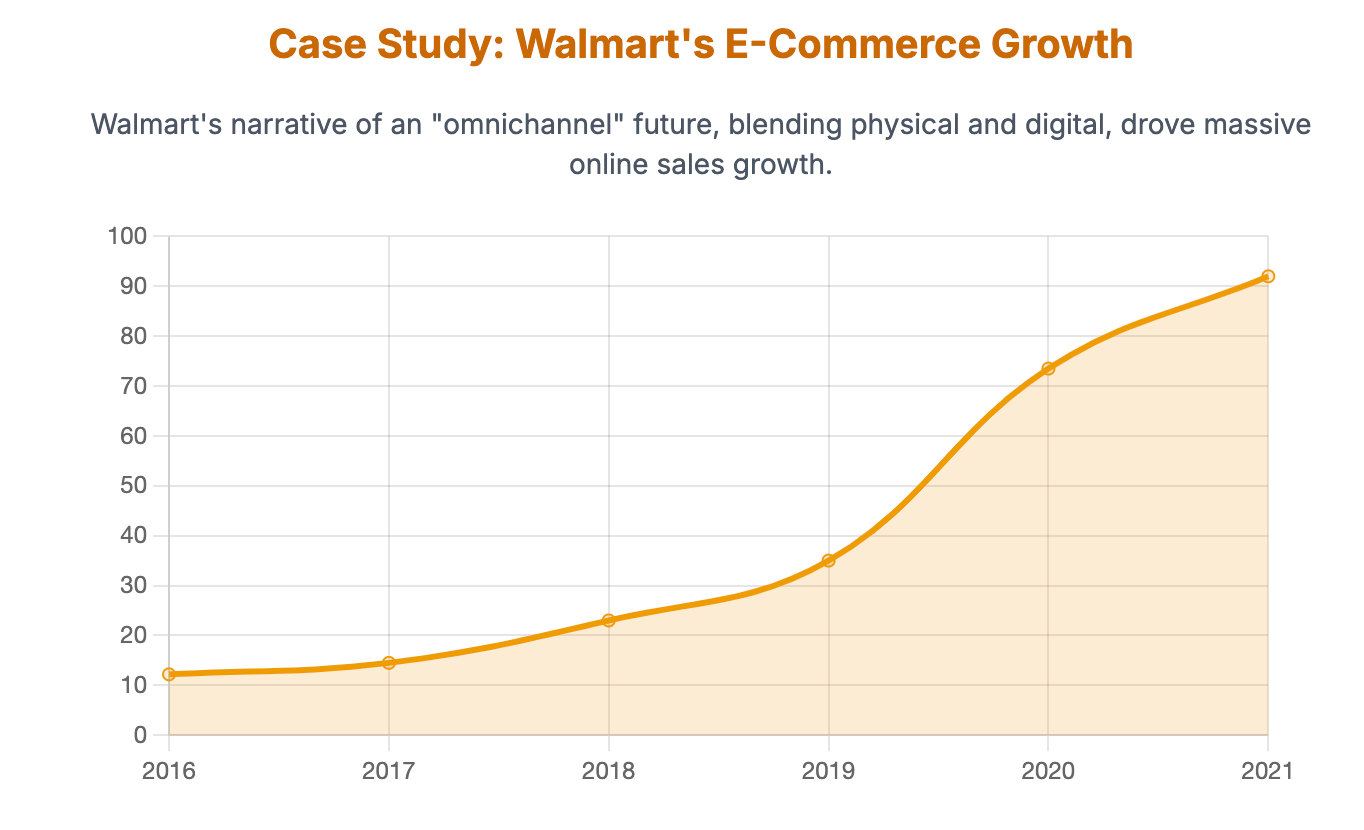Pre-Change Narratives: The Story Behind Successful Digital Transformation
Pre-change narratives align stakeholders before digital transformation begins, helping incumbents and scale-ups alike drive cultural adoption, preserve agility, and embed purpose—proving that people follow stories, not spreadsheets, in times of change.
With 7 out of 10 digital transformation programmes failing ‘pre-change narratives’ are a powerful communication tool used to explain the purpose, vision, and journey of a transformation to create alignment among all stakeholders before any steps (or missteps) are taken.
In this issue we explore them - and the different approaches taken by digital scale-up, and pre-digital incumbent. businesses.
Why Pre-Change Narratives Matter for Incumbents
For established enterprises navigating digital transformation, the story often (indeed should) start before the strategy with a pre-change narrative - to explain the purpose and vision of the transformation journey.
Digital transformation is distinct from digitisation, which simplifies work using digital data, and digital optimisation, which improves existing processes and customer experiences. A true transformation, as seen in companies like Netflix and Amazon, involves reinventing how an organisation serves its market through the creation of entirely new products, services, or business models.
The distinction matters. Research shows that around 70% of digital transformation projects by incumbent (pre-digital era businesses) fail.
In practice digital transformation is a business strategy that integrates digital technology across all areas of an organisation with the goal of fundamentally modernising an organization's processes, products, and operational models to enable continuous, customer-driven innovation.
This evolution can involve everything from embedding digital technology into existing products, such as in the automotive industry, to reinventing entire business models and creating new revenue streams
As legacy systems and shareholder corporate cultures resist sudden disruption, large companies with legacy (pre-digital) businesses like Adobe and Microsoft invested in carefully curated pre-change narratives - frameworks that define the “why” behind the transformation.
Microsoft’s shift under CEO Satya Nadella, for example, began not with new tools but a transformed mission: moving from a “know-it-all” to a “learn-it-all” culture.
Walmart’s embrace of a multi or ‘omnichannel’ retail narrative helped the company to 10x e-commerce sales between 2016 and 2021 (see chart, All channels, all the time, below).
The narrative shift positioned employees as protagonists in a learning journey, a strategy which helped reduce or prevent technical scepticism among staff by getting emotional and strategic buy-in.
Harvard Business Review says successful pre-change storytelling involves six key pillars:
Shared purpose
Conflict clarity
Leadership legitimacy
Rhythm
Audience insight
And reinforcing examples through internal stories from early adopters or champions
Scale-Up Storytelling: Adaptive Beats Predictive
As the pace of technological change accelerates, no company is immune to the need to keep pace and adapt. Including startup and fast scaling companies.
While the culture of digital firms serves them well - often defined by an ability to accept change as the only constant, and a multi-disciplinary team approach so that innovations are not siloed or sidelined - they face a unique challenge: scaling without losing the founding culture and speed that fueled their initial success.
Their narrative mechanisms tend to be leaner and faster, and their public relations strategies focus on building brand awareness and humanising the brand through founder-led storytelling to attract early customers and investors.
The core challenge is not overcoming institutional inertia but installing a new, often unwritten, culture before it is lost in the bureaucracy that comes with rapid growth. For a fast-scaling company, the narrative serves as a living blueprint for how employees should work and interact. It acts as a north star that provides guardrails for decentralised decision-making, allowing the company to scale without losing the speed and innovation of a small team.
The narrative must define and reinforce core values, such as "freedom and responsibility," that enable agility in a large organization.Unlike incumbents, which often require board-level consensus and multi-layer cultural permissioning, scaleups focus on building emotional momentum and permission to evolve.
As a result their narratives form around rapid feedback loops and iterative storytelling: decks, internal town hall stories, and design sprints aligned with vision.
For instance, AI design platform Figma framed its mission ("make design accessible to all") as both a product value and change driver when it went through integrations and product streamlining prior to its $20bn acquisition announcement.
Netflix’s focus on personalisation and on-demand entertainment as the core of its narrative has seen the company grow its subscriber base to 220 million (from 20 million) in the 5 years to 2021 (see chart, Up and Away, below).
Leaders in these companies often test narrative ‘resonance’ with teams as actively as they test product features. This makes storycraft a living asset not just a formal doctrine that gets forgotten when not needed.
Shift happens: Points of Divergence (and Convergence)
What sets incumbent-led transformations apart from scale-up narratives isn't just size or sector - it’s the storytelling architecture. Incumbents focus on context. Their stories often begin by unpacking legacy systems and market trappings, drawing internal links between past success and needed reinvention.
European bank BBVA's shift to open banking began with carefully contextualizing trusted banking heritage with customer-first innovation stories. In contrast, a Series C startup shifting to AI tooling might start by aligning around what’s broken today and how they’re uniquely poised to fix it without the burden of having to think about the impact on their reputation.
Whichever end of the business spectrum you’re on, a fledgling start-up or global multinational, both approaches converge on one truth: people don’t follow spreadsheets or strategies - they follow stories.
The more those stories make employees feel seen, trusted, and central to change, the easier it is for digital transformation to catch fire before the first line of code is written.
Big v Getting Bigger: Narrative goals for scale-ups & incumbents
Recommendations for Incumbent Leaders
Leaders of incumbent firms should position their pre-change narratives to navigate the unique challenges of their status as established, incumbent firms in their industry or market:
Directly address the tensions of change through communication by framing digital initiatives not as a replacement for their legacy but as a means to augment and enhance it.
Invest in a cultural narrative first, before any large-scale technology deployment - frame the journey as an "endurance race" that requires persistence and a "learn-it-all" mindset.
Communicate the narrative clearly and consistently by a C-suite leader with full buy-in to signal unwavering commitment and build the momentum for a multi-year effort.
Recommendations for Scaling Founders
For fast-scaling companies, the strategic priority is to solidify their culture and operational model through narrative early on, as Spotify did, to prevent cultural drift as the company grows.
Use founders’ personal, transparent narratives to build trust and rally their community during periods of hyper-growth or crisis (as exemplified by Airbnb's response to the pandemic).
Ensure simplicity and cohesion in use of internal technical narratives, such as Block's "Lego blocks" metaphor, so they become a powerful external brand story, making complex technology understandable to a broad audience.
Outlook: The Evolving Role of Organisational Storytelling
As technology - and its reach - continues to evolve, the role of organisational storytelling will only grow in importance.
With AI becoming embedded in companies and customers' daily lives, future digital transformations will likely see the use of advanced technologies, like AI, to personalise transformation journeys for individual employees.
At the same time an increasing focus on ethical business practices will require narratives that build trust through honest communication and a commitment to core values.
In an era where technological disruption is a constant, the ability to craft a compelling story - one that combines shared purpose, provides comfort in uncertainty, and inspires action - remains the ultimate competitive advantage for any organisation, no matter your size - or your legacy.
Case Study 1
Spotify | "Squads, Tribes, Chapters" Model
Spotify's digital transformation narrative is unique because it is embodied by its organisational model itself. The "Spotify Model" is a structural and cultural narrative for maintaining agility and speed at scale. The company documented this model and shared it with the world, turning an internal process into a de facto industry standard and a core part of its brand identity.
The model's narrative principles are rooted in autonomy, self-management, and decentralised decision-making, using a playful, non-traditional structure (Squads, Tribes, Chapters, and Guilds) to communicate a complex organisational design. By focusing on "organising around work" rather than rigid, bureaucratic processes, the narrative empowered teams to move fast and ship software quickly.
👉 Key Insight: This narrative resulted in accelerated product releases, improved team collaboration, and higher employee engagement, proving that a well-documented internal model can become a powerful external brand narrative.
Case Study 2
Roche | Turning Scientists into Storytellers
Pharmaceutical giant Roche, traditionally driven by scientific rigour, faced the challenge of aligning thousands of researchers and medical teams around a rapidly evolving digital R&D pipeline.
To navigate this, Roche created a multi-phase story arc internally: from “Data-Lake Dreams” to “Personalised Precision.” The company hosted workshops where scientists helped define the transformation lexicon - what AI and digital tools would mean for patient-centricity, not just lab throughput. Internal story ambassadors were seeded in R&D departments, who cascaded transformation narratives built by and for scientists. The approach was subtle and intensely human: instead of mandating change, Roche invited teams to co-author it.
👉 Key Insight: By treating its workforce as authors, not just audiences, Roche built consensus through co-creation of its transformation language.
Case Study 3
Microsoft | "Learn-It-All" Transformation
In 2014, Microsoft was a legacy firm grappling with cultural stagnation and a decline in market relevance. Under CEO Satya Nadella, its pre-change narrative was not based on technology but on a cultural pivot. The core story was the shift from a siloed, internally competitive "know-it-all" culture to an empathetic, collaborative "learn-it-all" culture.3 Nadella anchored this narrative in the "growth mindset" philosophy, which encouraged curiosity, adaptability, and the willingness to learn from failure without fear.
Nadella's people-first approach and empathetic leadership directly countered the rigid, confrontational style of his predecessors. He backed this narrative with bold, strategic decisions, including a full pivot to the Azure cloud platform and a shocking embrace of open-source development and partnerships with former rivals. The narrative of cultural renewal translated directly into business success, with Microsoft's market capitalisation soaring from $300 billion to over $2.5 trillion by 2023.Azure became a dominant competitor to Amazon Web Services, and employee engagement and satisfaction increased significantly.
👉 Key Insight: Leadership narrative coherence - across vision, voice, and behaviour - built enduring alignment across 200K employees.
A. Up and Away: Netflix Subscriber Growth 2011-21 (millions)
B. All channels, all the time: Walmart’s E-commerce sales ($ billion)
Want practical tools to craft your own pre-change transformation storyline?
👉 Check back to download our free Transformation Narrative Canvas (coming soon)
👉 Or subscribe to the Storied. podcast for weekly interviews with real leaders making change happen through story.
We’re now live on Substack!
Like this article? For more content on the power of storytelling as wells insights and free tools for leaders to help you build the storytelling muscle visit Storied. my newsletter on Substack







